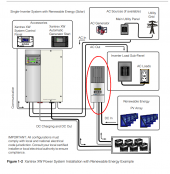Hi Everyone,
My family and I are the proud new owners of an amazing property in the New England, NSW. It has been set up off grid and is somewhat of a dream come true.
Unfortunately I have minimal experience in off grid living and despite many hours of research remain quite bewildered. The basics:-
1) Batteries 24 x BAE PVV 2v 1800 -
2) Inverter Xantrex (now Schneider) - XW4548 -230-50
3) Panels Kyocera KD-135SX-1pu
4) Time in operation estimated 8-10years
I have a few questions which I hope the combined wisdom of the forum may answer:-
1) My batters have a c10 1440Ah and c100 1900Ah. On my inverter which figure to I enter?
2) I generally understand that in a 3 stage charging cycle I there is the bulk, absorption and then float. Can this happen from solar inversion or does it need a AC qualified load.
3) What should I set the bulk and absorption rate at - the date sheet suggest 2.33v o 2,4v which is 55.2V to 57.6 - I have set lower to avoid damage and hopefully trigger absorption without luck.
4) Float charge on the battery data sheet is is 2.25v - I believe I am safe with 54v?
4) Do I equalize GEL batteries - the battery manual suggests yes (which I guess would be right) but the manual suggests no. If yes the fact sheet suggests 2.33-2.4v which appears low noting its the same voltage as the bulk and absorption level.
General performance - so far the system is doing everything we want it to. However I am concern that the batteries are damaged (left to sit a few year before we bought the place.)
This week end past we hook a 1amp generator and ran it. Charge voltage now peaks at about 55.2V in the day - although by morning is about 49.6v.
From my reading I suspect that the batters have discharged and wondering if an equalisation might help?
Otherwise I am not sure how best assess the health of the batteries and how long they may be for the world.
Generally we run a fridge - freezer and a few appliances such that there is standby draw of 230w per hour. The regular cup of tea throughout the day. We use wood for heating and gas for cooking. There is a TV an associated comforts for night.
In short I believe the system we have is likely significantly larger than our needs and I am keen to out off the (inevitable) re-investment into new batteries as long as practical.
I say a thank you in advance to any thoughts
Yours
Glen
My family and I are the proud new owners of an amazing property in the New England, NSW. It has been set up off grid and is somewhat of a dream come true.
Unfortunately I have minimal experience in off grid living and despite many hours of research remain quite bewildered. The basics:-
1) Batteries 24 x BAE PVV 2v 1800 -
2) Inverter Xantrex (now Schneider) - XW4548 -230-50
3) Panels Kyocera KD-135SX-1pu
4) Time in operation estimated 8-10years
I have a few questions which I hope the combined wisdom of the forum may answer:-
1) My batters have a c10 1440Ah and c100 1900Ah. On my inverter which figure to I enter?
2) I generally understand that in a 3 stage charging cycle I there is the bulk, absorption and then float. Can this happen from solar inversion or does it need a AC qualified load.
3) What should I set the bulk and absorption rate at - the date sheet suggest 2.33v o 2,4v which is 55.2V to 57.6 - I have set lower to avoid damage and hopefully trigger absorption without luck.
4) Float charge on the battery data sheet is is 2.25v - I believe I am safe with 54v?
4) Do I equalize GEL batteries - the battery manual suggests yes (which I guess would be right) but the manual suggests no. If yes the fact sheet suggests 2.33-2.4v which appears low noting its the same voltage as the bulk and absorption level.
General performance - so far the system is doing everything we want it to. However I am concern that the batteries are damaged (left to sit a few year before we bought the place.)
This week end past we hook a 1amp generator and ran it. Charge voltage now peaks at about 55.2V in the day - although by morning is about 49.6v.
From my reading I suspect that the batters have discharged and wondering if an equalisation might help?
Otherwise I am not sure how best assess the health of the batteries and how long they may be for the world.
Generally we run a fridge - freezer and a few appliances such that there is standby draw of 230w per hour. The regular cup of tea throughout the day. We use wood for heating and gas for cooking. There is a TV an associated comforts for night.
In short I believe the system we have is likely significantly larger than our needs and I am keen to out off the (inevitable) re-investment into new batteries as long as practical.
I say a thank you in advance to any thoughts
Yours
Glen



